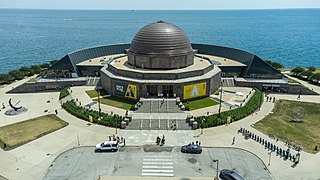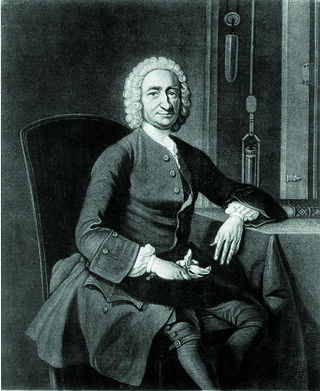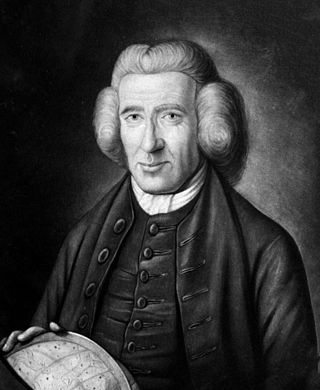
A planetarium is a theatre built primarily for presenting educational and entertaining shows about astronomy and the night sky, or for training in celestial navigation.

An orrery is a mechanical model of the Solar System that illustrates or predicts the relative positions and motions of the planets and moons, usually according to the heliocentric model. It may also represent the relative sizes of these bodies; however, since accurate scaling is often not practical due to the actual large ratio differences, a subdued approximation may be used instead. Though the Greeks had working planetaria, the first orrery that was a planetarium of the modern era was produced in 1713, and one was presented to Charles Boyle, 4th Earl of Orrery – hence the name. They are typically driven by a clockwork mechanism with a globe representing the Sun at the centre, and with a planet at the end of each of the arms.

The Adler Planetarium is a public museum in Chicago, Illinois, dedicated to astronomy and astrophysics. It was founded in 1930 by local businessman Max Adler. Located on the northeastern tip of Northerly Island on Lake Michigan, the Adler Planetarium was the first planetarium in the United States. It is part of Chicago's Museum Campus, which includes the John G. Shedd Aquarium and The Field Museum. The Planetarium's mission is to inspire exploration and understanding of the universe.

David Rittenhouse was an American astronomer, inventor, clockmaker, mathematician, surveyor, scientific instrument craftsman, and public official. Rittenhouse was a member of the American Philosophical Society and the first director of the United States Mint.

Morehead Planetarium and Science Center is located on the campus of the University of North Carolina at Chapel Hill. As a unit of the university, Morehead receives about one-third of its funding through state sources, one-third through ticket and gift sales, and one-third through gifts and grants.

George Graham, FRS was an English clockmaker, inventor, and geophysicist, and a Fellow of the Royal Society.

The London Planetarium building is located on Marylebone Road, London. It is adjacent to and owned by Madame Tussauds. It previously housed a planetarium, offering shows related to space and astronomy. In 2006, it was closed as a separate attraction and became part of Madame Tussauds. Since 2010, the building that previously housed the London Planetarium had a Marvel Super Heroes 4D attraction.

James Ferguson was a Scottish astronomer. He is known as the inventor and improver of astronomical and other scientific apparatus, as a striking instance of self education and as an itinerant lecturer.

The McLaughlin Planetarium is a former working planetarium whose building occupies a space immediately to the south of the Royal Ontario Museum in Toronto, at 100 Queen's Park. Founded by a grant from philanthropist Colonel R. Samuel McLaughlin, the facility was opened to the public on October 26, 1968. It had, for its time, a state-of-the-art electro-mechanical Zeiss planetarium projector that was used to project regular themed shows about the stars, planets, and cosmology for visitors. By the 1980s the planetarium's sound-system and domed ceiling were used to display dazzling music-themed laser-light shows. The lower levels of the planetarium contained a gallery called the "Astrocentre" that featured space-related exhibits, related artifacts on the history of astronomy and was also home of the world's first commercial Stellarium
Jens Olsen was a clockmaker, locksmith and astromechanic who built the famous world clock located in the city hall of Copenhagen, the Rådhus. He was born in Ribe, Denmark. Ever since he was a small child, Olsen was interested in clocks and other mechanical devices. After hearing of the broken clock in Carsten Hauch's A Polish Family, he dreamed of fixing that clock. Later, he envisioned a clock that would show every conceivable type of time, from sidereal time to the rotation of the planets.

Celestial cartography, uranography, astrography or star cartography is the aspect of astronomy and branch of cartography concerned with mapping stars, galaxies, and other astronomical objects on the celestial sphere. Measuring the position and light of charted objects requires a variety of instruments and techniques. These techniques have developed from angle measurements with quadrants and the unaided eye, through sextants combined with lenses for light magnification, up to current methods which include computer-automated space telescopes. Uranographers have historically produced planetary position tables, star tables, and star maps for use by both amateur and professional astronomers. More recently, computerized star maps have been compiled, and automated positioning of telescopes uses databases of stars and of other astronomical objects.

A Philosopher Lecturing on the Orrery, or the full title, A Philosopher giving that Lecture on the Orrery in which a lamp is put in place of the Sun, is a 1766 painting by Joseph Wright of Derby depicting a lecturer giving a demonstration of an orrery – a mechanical model of the solar system – to a small audience. It is now in the Derby Museum and Art Gallery The painting preceded his similar An Experiment on a Bird in the Air Pump.
Vice Admiral Washington Shirley, 5th Earl Ferrers, FRS was a British Royal Navy officer, peer, freemason and amateur astronomer.

The Royal Eise Eisinga Planetarium is an 18th-century orrery in Franeker, Friesland, Netherlands. It is currently a museum and open to the public. The orrery has been on the top 100 Dutch heritage sites list since 1990. In September 2023, it received the status of UNESCO World Heritage Site. It is the oldest working orrery in the world.

John Fulton (1803–1853) was a Scottish instrument maker who originally trained as a cobbler. He built three orreries in a workshop attached to at his home, now demolished, in the Kirton Brae area of Fenwick and was eventually appointed instrument maker to King William IV, moving to London, but retiring to Fenwick. He is buried in the Fenwick Kirk graveyard.
Where in the Universe Is Carmen Sandiego? is an educational planetarium program and live theatrical production and part of the Carmen Sandiego franchise. Licensed to planetariums across the US, Canada, and Japan, the show premiered in 1998 or 1999. The program featured the effects work of Adrian Ropp and was produced by Dr. William A. Gutsch, with music composed by Mark Mercury. Inspired by the successful television programs Where in the World Is Carmen Sandiego? and Where in Time Is Carmen Sandiego?, the series aimed to promote listening and math skills through interactive sessions rather than relying on memorized facts. The shows encouraged audience participation by incorporating question-and-answer segments.
Henry C. King was a British astronomer and writer.
Moses Holden was an English astronomer, known particularly for giving lectures on astronomy.

Adam Walker was an English writer and inventor. He gave lectures on astronomy, aided by one of his inventions, the eidouranion.














